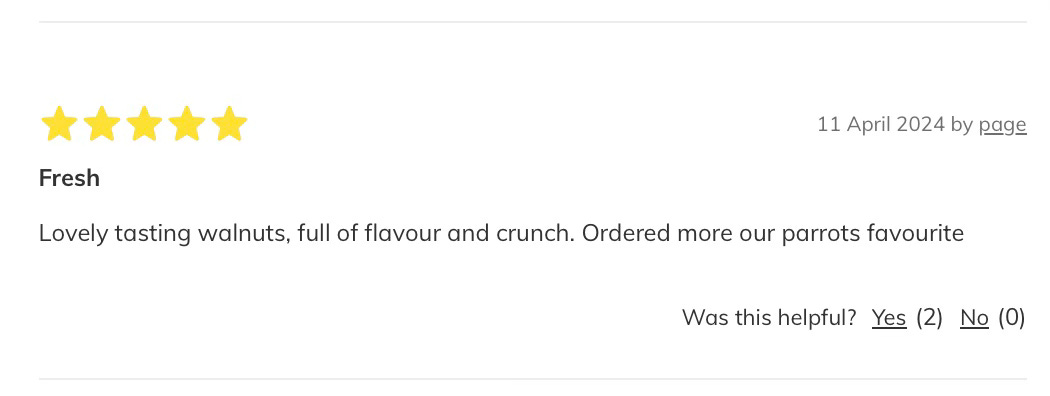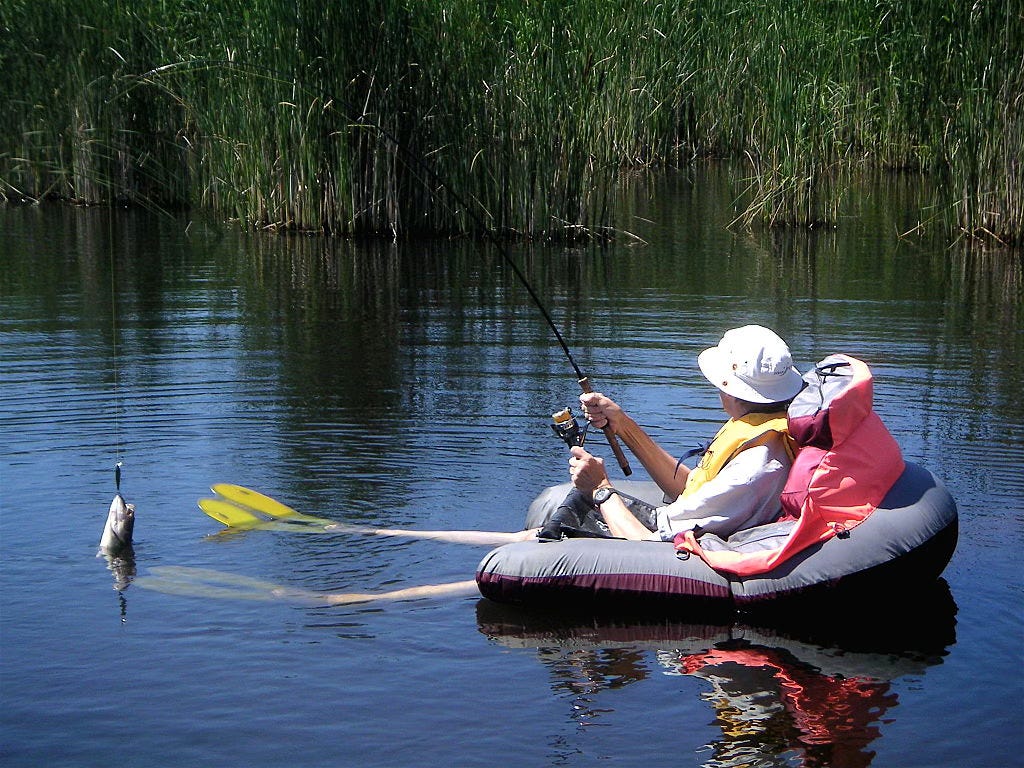150. ✒️ A letter to Terry: reply #24-11
Will drinking even more tea improve my word count, and can one really fly-fish from an armchair?

In which Rebecca wonders whether matching Edgar Wallace’s tea consumption will increase her writing output, is tempted (by a five-star review for walnuts) to buy a parrot as a pet, and is impressed at the laid-back approach of a fellow camper to catching trout for his supper.
✒️
This is the latest letter in my regular, informal correspondence with Substacker and fellow Brit Terry Freedman, in which we take turns every other Wednesday to delve into the things that British people talk about the most. So that you can explore these unashamed clichés for yourself we’re inviting you to read our letters over our shoulders.
My next ‘Dear Reader, I’m lost’ post will of course be published on Saturday.
Dear Terry,
Thank you for your recent letter, in which you dropped the caffeinated bombshell that drinking thirty to forty cups of tea a day is an achievable aspiration – or at least it was achievable by prolific writer Edgar Wallace. I wonder whether I can establish a direct relationship between my own tea consumption and my word count? 🤔 I shall report back.
I did some of my own research into Wallace, and was happy to find that Gutenberg Australia had made the ebook of Edgar Wallace – Each Way, written by Wallace’s personal typist Robert Curtis, available for free.
Curtis describes both Wallace’s writing output and his tea input in the same chapter, which makes me think that the two activities must be directly related. Although Curtis has not expressed such a correlation in so many words, Terry, let’s be reasonable and draw the obvious conclusion for ourselves. Check out Chapter 4 in the link above, and I’m sure you’ll agree.
The number of books to his credit cannot be exactly stated, but it is between 150 and 160. The question arose while we were in Hollywood. It was at lunch one Sunday, and, although there was a big programme of work before us, the waffles which accompanied the roast beef had been succulent, and with the arrival of each instalment work receded farther and farther into the future, as it were. We spent the half-hour following lunch in compiling a list of titles. Wallace had written them all; I had read them all, and been concerned in the preparation of a great many; but, try as we did, we could not extend the list beyond 118.
Wallace was certainly the only author of our time who had forgotten the titles of thirty-five or forty of his own books.
[…]
What he could not work without was tea. […] A large breakfast cup of tea was brought to him about every half-hour of the day. It was his favourite beverage, strange as it always appeared to me. I tried to cultivate the habit at first, drinking cup for cup with him during months, but I gave it up in the end.
Thirty or forty cups of tea daily was his average consumption.
From Edgar Wallace – Each Way by Robert (Bob) Curtis, first published by John Long, London, 1932.
Blimey. Oh, and I rest my case.
You have rightly taken me to task over my reaction to the lines from a scathing book review, for which I had criticised the person responsible for being so mean about the author whose work they were judging.
You asked me this, in response:
I know you think that scathing book reviews are mean, but assuming they’re honest, mean to whom? Do you not think that the reviewer owes more to the would-be reader than the author?
Those aren’t easy questions to answer, but although I will admit that yes, the reviewer perhaps does have a greater responsibility to their own reader than to the author of the book itself, I feel they might have considered using a phrase kinder than ‘This is the most unreadable book I have ever read.’
At last it’s salad season, and homemade Waldorf is one of my favourites. During a search for some decent walnuts for the job on my online grocery supplier’s app last month I came across this review:

Very useful, I’m sure, but now I’m going to have to acquire a parrot to feed them to. 🙄
How’s the weather been treating you, Terry? We had a few very warm days, but on our walk along Eastbourne beach yesterday we had to lean into the wind so as not to blow over backwards. Here’s how my new haircut reacted to the experience:
It was so windy that I wondered how all the people fishing were managing not to get their lines tangled up with each other. I kept my distance so as not to be spiked by any flying fishhooks.
On the subject of fish, on our recent camping trip to Devon I looked across to the motorhome on the pitch opposite ours, whose inhabitants – a couple a little older than us – were sitting reading newspapers in the shadow of a whirligig washing line on which was hanging what looked like a pair of baggy dungarees. On the ground next to the washing line was what I can only describe as half an inflatable boat, and leaning against that was a pair of diving fins.
Waders?
Flippers?
A boat that wasn’t a whole boat? What on earth…?
We’d walked down the very steep gorge to Devil’s Cauldron earlier in the day, and I wondered if the couple were adrenaline junkies who’d risked life and limb by hurling themselves into the crashing, foamy water. Perhaps the half-boat was actually a rubber ring, and the waders and flippers were protective gear….? 🤔 Surely not.
After a while the chap got up to fetch something from inside the motorhome, and soon he was kneeling on the grass, his newspaper now spread in front of him, with something glistening silver and orange just visible as he leaned over to work on what was clearly a painstaking task.
Terry, he was filleting trout! 🙌
I had a brief opportunity to chat with his wife as we passed her on our walk to the pub, and explained that I’d been trying to work out the context of the waders, fins and funny-looking boat that I’d spotted. ‘Then I saw the trout, and realised you must have been fishing!’
‘That’s right: my husband’s really into float tubing!’ she told me. ‘Oh yes, of course!’ I replied, nodding enthusiastically despite not having a clue what she was talking about.
Terry, I Googled it later, and it’s fascinating.
A float tube, also known as a belly boat or kick boat, is a small, lightweight inflatable fishing craft which anglers use to fish from. They were originally doughnut-shaped boats with an underwater seat in the "hole." Modern designs include a V-shape with pontoons on either side and the seat raised above the water allowing the legs of the angler to be the only part of the body to be submerged. Float tubes are used for many aspects of fishing, such as flyfishing for trout or lure fishing for largemouth bass, and enable the angler to fish areas otherwise not fishable from the bank.
Float tubes are either U-, V-shaped, or circular. A standard float tube consists of an inflated bladder inside a sewn cover providing the seat, reserve air compartments, and tackle storage pockets.
I don’t know where exactly the chap had been fishing, but I found these instructions for how to get into the float tube on the website of a fishing club at Siblyback, a lake fairly close to our campsite:
For the benefit of anyone who has not used a float tube before, the technique is to put your fins on at the water’s edge and put the tube into the water with the seat facing the shore. Keep hold of the tube with one hand whilst slowly and carefully walking backwards until the water reaches your knees. You can then carefully sit on the seat, if your tube has a crotch strap now is the time to connect it and the stripping apron. Push the tube back with your feet until you are in a suitable depth for kicking with your fins.
Once out on the water you will be at peace fishing from the comfort of an armchair! There is no need to cast far and you can drift right into the fishy areas without disturbing the fish.
Wow, Terry: armchair fishing!

I am pleased to report that I have finally solved the challenge of the crossword clue you had set me, but I’ll admit to having found it very difficult.
Bow Road tube station (7) was such a clever clue, in that Bow Road1 is a tube station! That red herring distracted me for days, but in fact it had been hiding a very straightforward answer.
Ready?
Tube station is telling me that the answer to the clue is, well, a tube station – so I know that I’m looking for the name of a tube station with seven letters – and Bow Road is the part of the clue that will lead me to the answer.
Bow = arch
Road = way
The tube station with 7 letters is Archway!2
I’ve got one for you in retaliation. Now, I’ve made this one up myself, rather than pinching it from the Daily Telegraph like my last one, or The Times, like yours, so it’s not as clever. Still, perhaps you’ll let me know in your next letter what answer you came up with, and explain how you got to it:
Gift from a spy, we hear, in luxury shopping district (4, 6)
All the very best, as ever,
Rebecca
If you’ve enjoyed reading this letter to Terry, please let me know by clicking the heart. Thank you! My next ‘Dear Reader, I’m lost’ post will be published on Saturday.
You’ll find the rest of my letters in this series by clicking the ‘Letters to Terry’ tab on the top bar of my home page. Terry and I take it in turns to write to each other on alternate Wednesdays, and I really enjoy our light-hearted correspondence! You can access both Terry’s letters and mine using the index below:
Check out Terry's fabulous newsletter, and to make sure you don’t miss his reply to this letter next week, why not subscribe?
Last but not least, do please share and subscribe for free! Thank you!
Bow Road station is served by both the District Line and the Hammersmith & City Line.
Archway station is located on the High Barnet branch of the Northern Line between Highgate and Tufnell Park stations.






I don't know Rebecca, but I think that if I drank 40 cups of tea a day, 75% of my day would be spent in the bathroom. I do love the fishing chair if it could be a reading chair
I think I’ve solved it, however, as I am not at all a cryptic crossword person, I may be barking up the wrong tree completely as the answer seemed obvious to me. Therefore I await the official answer with interest.